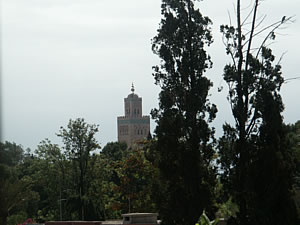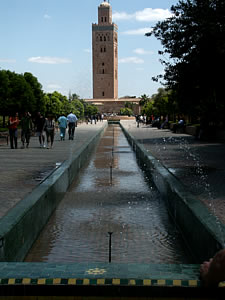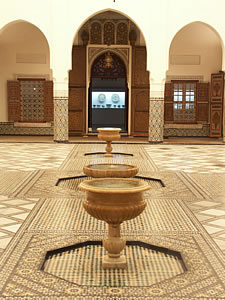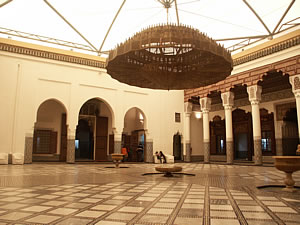| |
A
trip to Morocco
Part 1: Through
the window we see a mosque
The southbound plane descends through clouds. The ground looks
red and rocky. It is at an odd angle. The plane banks steeply
left. It turns in a semicircle. We see palmtrees. We land.
The pilot taxis to park close to the terminal. We descend
on foot. The air is warmer than in Paris.
|
|
|

|
We
give immigration staff the forms filled out in the plane.
They give back forms to return when leaving. We collect our
baggage. We pass through the green channel without incident.
A crowd is waiting at the exit. Taxi drivers importune us.
A man with a broken tooth holds a sign saying "La famille
HOLMES". He takes us past more taxi drivers. He puts
our bags and us in a minibus.As he drives, he jokes with us.
His name is, predictably, Abdul. The drive to the three star
hotel in l'Hivernage is short. Abdul
unloads our baggage and takes us into the Akabar hotel. He
smiles and says goodbye. I would tip him, but I have no money,
only a creditcard.
|
|
|
|
|
We
fill in forms. We go to our topfloor rooms. We unpack. Through
the window we see a mosque. Everywhere there are palmtrees
and foliage. I walk about a hundred yards to a cash distributor.
I return to the hotel. We go to eat. The food is "western".
It is mediocre. We are tired despite the short flight. There
is a two hour time difference. A last minute flight change
meant we spent five hours at the Paris airport. We go to bed.
|
|
|
|
We
wake up. Was it the muezzin from the mosque? We see small
groups of birds flying and wheeling together. A stork flaps
slowly across the sky in front of the mosque. Everything is
very green. We go down to breakfast. We are in a courtyard
with a corrugated plastic roof. It is hot. Flies buzz around.
We are seated by the smiling black waitress. She disappears.
We wait. Everybody else waits. We wait. It is waitress service.
An Arab boy of twelve or thirteen dressed as a waiter smiles
at us. He does nothing. Finally a man serves himself. Then
everyone serves themselves. Henry James wrote that society
is like a sheep crossed with a parrot. There are miniature
croissants, bread, butter and jam, orange juice, tea and coffee.
Rain
drums the roof. It leaks over one of the tables. The cloudburst
ends. Water lies in pools outside. We have no raincoats, no
umbrellas. We decide to risk it.
|

|
|
|
|
We
walk out and take a taxi to the huge central square - Jamaa
el-Fna. We enter the pinkish city walls by a large gate. We
go past the Koutoubiya mosque we saw from our hotel window.
It is surrounded by formal gardens. The minaret is a high
pink tower.
|
|
|
|
|
|

|
Jamaa
el-Fna swarms with snakecharmers, acrobats, musicians, fortunetellers,
storytellers, hennapainters, monkeycarriers, watersellers
with bright costumes. There are lines and lines of orangejuice
stalls, street restaurants. We walk north to the Koranic school.
The pink streets are too narrow for cars. There are bikes,
scooters, and donkeycarts carrying building materials.
We hesitate. Would-be guides press themselves on us. We refuse
politely. We were warned. We are asked "How many camels
for the gazelle?" by passers-by. The gazelle is my daughter.
The passers-by are too poor to have camels. The gazelle is
fourteen. She is not for sale.
We
pay to go in to the pink Koranic school, Ben Youssef Madrasa.
There are intricately patterned ceilings. There is a courtyard
with fountains. There
are elaborately tiled rooms and recesses.
|
|
|
|
|
All
the rooms are bare. The school has an austere beauty. The
Ben Youssef Madrasa school is near the Ben Youssef mosque.
The Museum of Marrakesh is next to the mosque. We are hungry.
We decide to visit the Museum after lunch. We
walk back to Jamaa el-Fna. We are assailed by offers for the
gazelle. One hundred camels, two hundred, a thousand, three
thousand, they shout.
|
|
|
|
|
We
eat at Chez Chegrouni overlooking the square. It serves Moroccan
food. It is crowded and cheap. It is full of tourists. There
are two couples from our hotel. It rains heavily while we
eat. The rain ceases. We walk back to the Museum. It starts
to rain.
The
Museum houses contemporary Moroccan art. It is linked to traditional
Moroccan culture. There are paintings with the Hand of Fatima.
I learn that it wards off the evil eye. There are paintings
with Arabic script traversing half the surface. The Museum
building is a former raid, a rich man's townhouse.
|

|
|
|
|
|
|
There
are intricately patterned ceilings, elaborately tiled rooms
and recesses, a courtyard with fountains. There is a hammam
with an exhibition of photos. Explanatory panels give narratives
by former hammam employees. They explain the place of the
hammam in Moroccan everyday life. The rain has stopped when
we leave.
Part
2: Some
things never change
this
travelogue is part of the subside travelzine
about bookshelf
links contact
submit
|
|
|